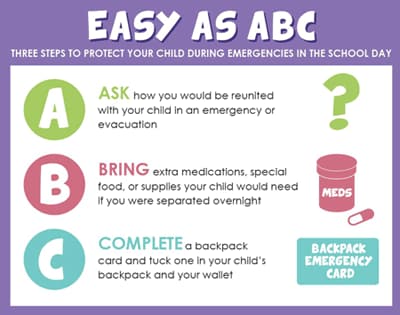Ask how you would be reunited with your child in an emergency or evacuation
- If students had to evacuate, where should you go to pick them up?
- How would the school notify you in the event of emergency?
Follow these three steps to help protect your child during emergencies in the school day. View larger version and text description.
Bring extra medication, special foods, or supplies your child would need if you were separated overnight
- What essential supplies would your child need if separated from you overnight? (Medications? Inhaler? Milk? Diapers? Battery pack for special equipment?)
- Does the school have an emergency stockpile of these items or could you bring extras to be kept at school?
- What is the school policy for how and when medicine can be administered to your child?
Complete a backpack contact information card [PDF – 171 KB] and tuck one in your child’s backpack and your wallet
- Emergencies are chaotic! Make sure your child or their school knows how to reach you, and who should be called if your phone isn’t working.
- Download and complete your own backpack card..."
Keeping children safe

